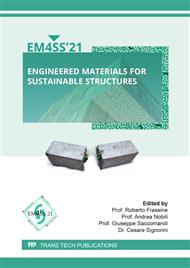[1]
J. Seelapureddy, J. Bommisetty, M. V. Seshagiri Rao, Effect of metakaolin and micro silica on strength characteristics of standard grades of self-compacting concrete. Materials Today: Proceedings, 45(2021) 884-890.
DOI: 10.1016/j.matpr.2020.02.936
Google Scholar
[2]
K. L. Scrivener, V. M. John, E. M. Gartner, Eco-efficient cements: Potential economically viable solutions for a low CO2 cement-based materials industry. Cement and Concrete Reaearch, 114(2018) 2-26.
DOI: 10.1016/j.cemconres.2018.03.015
Google Scholar
[3]
M. Frías, M. I. Sánchez, Eco-efficient concrete. Cambridge, United Kingdom, (2013).
Google Scholar
[4]
Y. Dhandapani, T. Sakthivel, M. Santhanam, R. Gettu, R. G. Pillai, Mechanical properties and durability performance of concretes with Limestone Calcined Clay Cement (LC3 ). Cement and Concrete Research, 107 (2018) 136–151.
DOI: 10.1016/j.cemconres.2018.02.005
Google Scholar
[5]
R. Fernandez Lopez, Calcined clayey soils as a potential replacement for cement in developing countries. Ph.D. thesis, Faculté Sciences et Techniques de L'ingénieur Laboratoire des Matériaux de Construction, École Polytechnique Fédérale de Lausanne, (2009).
DOI: 10.24295/cpsstpea.2019.00020
Google Scholar
[6]
A. Trümer, H. M. Ludwig, M. Schellhorn, R. Diedel, Effect of a calcined Westerwald bentonite as supplementary cementitious material on the long-term performance of concrete. Applied Clay Science 168 (2019) 36–42.
DOI: 10.1016/j.clay.2018.10.015
Google Scholar
[7]
E. F. Irassar, V. L. Bonavetti, C. C. Castellano, M. A. Trezza, V. F. Rahhal, G. Cordoba, R. Lemma, Calcined illite-chlorite shale as supplementary cementing material: Thermal treatment, grinding, color and pozzolanic activity, Applied clay, 179 (2019)10514.
DOI: 10.1016/j.clay.2019.105143
Google Scholar
[8]
Information on https://fireservice.abj.gov.ng/fire-statistics/jan-2019-report/.
Google Scholar
[9]
J. Damtoft J. Lukasik, D. Herfort, D. Sorrentino, E. M. Gartner, Sustainable Development and Climate Initiative. Cement and Concrete research, 38(2008) 115-127.
DOI: 10.1016/j.cemconres.2007.09.008
Google Scholar
[10]
K. L. Scrivener, Option for the Future Cement. Indian Concrete Journal, 88(2014), 11-21.
Google Scholar
[11]
Q.Q. Zhang, G. L Yuan, Y. N. Dong, Influence of Cooling Methods and Standing Time on Different Aggregate Concrete Strengths after Elevated Temperature. Advance Material Research, 250(2011)155–159.
DOI: 10.4028/www.scientific.net/amr.250-253.155
Google Scholar
[12]
G. Y. Kim, G. C. Choe, Y. W. Kang, T. G. Lee , Mechanical Properties of Concrete depending on Cooling Conditions After High Temperature Heating. Journal of Advanced Concrete Technology, 12(2014) 82-90.
DOI: 10.3151/jact.12.82
Google Scholar
[13]
J. Novak, A. Kohoutkova, A. (2018). Mechanical properties of concrete composites subject to elevated temperature. Fire Safety. Journal, 95(2018)66–76.
DOI: 10.1016/j.firesaf.2017.10.010
Google Scholar
[14]
Y. Zhai, Y. Li, Y. Li, S. Wang, Y. Liu, K. I. Song, Impact of high-temperature-water cooling damage on the mechanical properties of concrete. Construction and Building Materials, 215(2019) 233–243.
DOI: 10.1016/j.conbuildmat.2019.04.161
Google Scholar
[15]
ASTM C618-19, Standard Specification for Coal Fly Ash and Raw or Calcined Natural Pozzolan for Use in Concrete, ASTM International, West Conshohocken, PA, 2019, www.astm.org.
DOI: 10.1520/c0618-15
Google Scholar
[16]
ASTM C150/C150M-18, 2018. Standard specification for Portland cement, ASTM International, West Conshohocken, PA, 2018, www.astm.org.
Google Scholar
[17]
ASTM C33 / C33M – 18, Standard Specification for Concrete Aggregates, ASTM International, West Conshohocken, PA, 2018, www.astm.org.
Google Scholar
[18]
ASTM C39/C39M-18, Standard test method for compressive strength of cylindrical concrete specimens, ASTM International, West Conshohocken, PA,2018, www.astm.org.
Google Scholar
[19]
M.B. Karakoç, Effect of cooling regimes on compressive strength of concrete with lightweight aggregate exposed to high temperature. Construction and Building Materials, 41 (2013) 21–25.
DOI: 10.1016/j.conbuildmat.2012.11.104
Google Scholar


